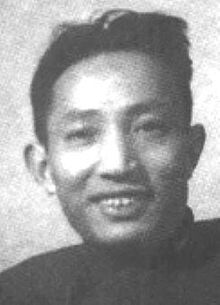Loading AI tools
Chinese painter From Wikipedia, the free encyclopedia
Fu Baoshi (Chinese: 傅抱石), or Fu Pao-Shih, (October 5, 1904– September 29, 1965) was a Chinese painter from Xinyu, Jiangxi Province. He went to Japan to study the History of Oriental Art in the Tokyo School of Fine Arts in 1933. He translated many books from Japanese and carried out his own research. In painting itself, he brought Japanese visual elements to the Chinese ink painting tradition.

He was the director of the Jiangsu Province Chinese Painting School and a vice-chairman of the Federation of Chinese Artists. He also taught in the Art Department of Central University (now Nanjing University).[1] His works of landscape painting employed skillful use of dots and inking methods, creating a new technique encompassing many varieties within traditional rules. He was able to create an old, elegant style through his integration of poetic atmosphere and painting techniques. He held many personal exhibitions in China and won favourable comments.
Fu had strong feelings towards the land of China. During his travel to many places, he recorded the splendors of the rivers and mountains, drawing inspiration from nature and becoming the representative landscape painter of his time.

Fu wrote numerous fine arts theses, the earliest of which, "On the Evolution of Chinese Paintings", was written at the age of 25. He also carried out in-depth research into the history of landscape painting at the end of the 4th century, including the works of Gu Kaizhi of the Eastern Jin dynasty (317–420), Zhan Ziqian of the Sui dynasty (581–618) and Jing Hao of the Five Dynasties period (907–960), as well as Wu Daozi, Li Sixun, Li Zhaodao and Zhang Yanyuan of the Tang dynasty (618–907). He worked very hard to imitate paintings by Gao Kegong and Ni Zan of the Yuan dynasty (1271–1368); Chen Hongshou of the Ming dynasty (1368–1644); and Cheng Sui, Kun Can, Zha Shibiao, Gong Xian, Mei Qing, Wui Li, Yun Shouping and Shi Tao of the Qing dynasty (1644–1911), finally becoming one of the master painters of his age. In this capacity he succeeded Huang Binhong, who had created a new style of landscape painting called "Baoshi's texture strokes" basing on the cattle-hair strokes of Wang Meng of the Yuan dynasty.[citation needed]

As well as painting landscapes, Fu Baoshi was also an accomplished painter of figures. His paintings of ancient Chinese figures from the 3rd and 4th centuries BC are particularly acclaimed.
Fu Baoshi was a great admirer of Shi Tao and, at the age of 18, changed his name to "Bao Shi" – meaning embracing "Shitao". He even wrote a chronicle of Shitao, recording his life experiences and social activities as well as his art creations. Fu Baoshi admitted that he was obsessed with the study of Shitao's painting.
As a leader of the so-called New Chinese Painting Movement, which reformed traditional Chinese painting after 1949, Fu stood out from most of his contemporaries with his great passion for art, and his innovative brushwork and unique picture composition.
Fu began to promote drawing from life tours in 1953.[2]: 144
Fu's reforms were followed by a group of artists in Nanjing where he then lived. He was recognized as the founder of the Nanjing-based New Jinling School of Fine Arts. The school included such important artists as Chen Zhifo (1896–1962), Qian Songyan (1898–1985), Song Wenzhi (1919–1999), Wei Zixi (1915–2002) and Ya Ming (1924–2002).
As part of the New Guohua Campaign encouraged by the state during the Great Leap Forward, Fu was elevated to major leadership positions at art institutions and was appointed to the Chinese People's Political Consultative Conference.[2]: 138 Along with Guan Shanyue, Fu was commissioned by China's central government to supply paintings for the Great Hall of the People.[2]: 141 The two were asked to incorporate the scenery of regions all over the country into one painting to symbolize the essence of the People's Republic of China.[2]: 141
In September 1960, following the inauguration of the Jiangsu Chinese Painting Institute (of which Fu was the director), Fu was part of a group of 13 guohua painters who visited a dozen places in six provinces as part of the "Twenty-three Thousand Li of Life Sketching".[2]: 144-145
In 1961, Fu went on a tour of the northeast to produce paintings of the region.[2]: 153 Among the places he visited was the Fushun coal mine, one of the most productive in the country.[2]: 152–153 Fu was initially reluctant to paint the scene, which a local Chinese Communist Party Committee Secretary had shown to him, deeming it not paintable or ugly.[2]: 153 According to Fu, Fu was surprised and moved by the party secretary's exclamation, "Look at the coal, how beautiful the color is!" and decided to paint the scene.[2]: 153 Fu sought to capture the robustness of the mine and what he saw as the grandeur of the mining enterprises, but found it difficult to show the layers of the coal's blackness using black ink.[2]: 153 The final piece is meidu zhuangguan (Spectacular view of the coal capital) (1964).[2]: 152
Seamless Wikipedia browsing. On steroids.
Every time you click a link to Wikipedia, Wiktionary or Wikiquote in your browser's search results, it will show the modern Wikiwand interface.
Wikiwand extension is a five stars, simple, with minimum permission required to keep your browsing private, safe and transparent.